Physical Address
304 North Cardinal St.
Dorchester Center, MA 02124
Benign eyelid lesions can arise from epithelial or dermal adnexal elements. These include epithelium, hair follicles, apocrine and eccrine glands, blood vessels, and nerves. Some may appear aggressive and must be differentiated from malignancies.
Three to six times more common than malignant neoplasms.
Can occur on any skin surface; some occur most often or exclusively on the eyelids.
May reflect local pathology or be manifestations of systemic disease.
Many lesions appear similar and present a diagnostic challenge.
Solid or cystic.
Epithelial or subepithelial.
Often multiple.
Confused with malignant neoplasms.
The eyelids may be affected by a wide spectrum of benign lesions. In studies that analyzed all eyelid lesions submitted for histopathological examination, benign lesions were three to six times more frequent than malignant neoplasms. Many lesions that affect the eyelids may occur on any skin surface, but some occur exclusively or more frequently on the eyelids.
The more common benign eyelid lesions are presented here, classified by origin, with each discussion highlighting the important clinical features, differential diagnosis, pertinent systemic associations, histopathology, and treatment.
A variety of histopathological changes affecting the layers of the epidermis may be observed in benign eyelid lesions. Hyperkeratosis, or thickening of the keratin layer, is seen clinically as an adherent scale. Parakeratosis is a form of hyperkeratosis characterized by incomplete keratinization with retention of nuclei within the keratin layer. Dyskeratosis is abnormal keratinization of cells within the squamous layer. Acanthosis, or thickening of the squamous layer, is commonly seen in proliferative epithelial lesions. Acantholysis refers to separation of epithelial cells.
Each type of epithelial tumor may exhibit some variability in its clinical picture and morphological features. In addition, different types of tumors may share similar clinical and morphological features, resulting in possible diagnostic confusion. A definitive diagnosis of these various lesions can only be made via histopathological examination.
The most common benign lesion of the eyelid is the squamous papilloma, also known as a fibroepithelial polyp, acrochordon , or skin tag . These lesions may be single or multiple and commonly involve the eyelid margin. Squamous papillomas characteristically are flesh colored and may be sessile or pedunculated ( Fig. 12.7.1 ). Diagnosis is made by the typical clinical appearance and histological characteristics. The differential diagnosis includes seborrheic keratosis, verruca vulgaris, and intradermal nevus. Microscopically, the lesion has finger-like projections (fronds) with a fibrovascular core, and the overlying epidermis demonstrates acanthosis and hyperkeratosis. Treatment is simple excision at the base of the lesion.

A cutaneous horn is a projection of packed keratin ( Fig. 12.7.2 ). This is a clinically descriptive term, not a diagnostic one. Cutaneous horns are not distinct pathological entities but may develop from a variety of underlying lesions, including seborrheic keratosis, actinic keratosis, inverted follicular keratosis, verruca vulgaris, basal cell carcinoma (BCC), squamous cell carcinoma (SCC), and other epidermal tumors. Because definitive therapy is dependent on the underlying cause, biopsy of the cutaneous horn (including the underlying epidermis) is required to obtain a histological diagnosis.
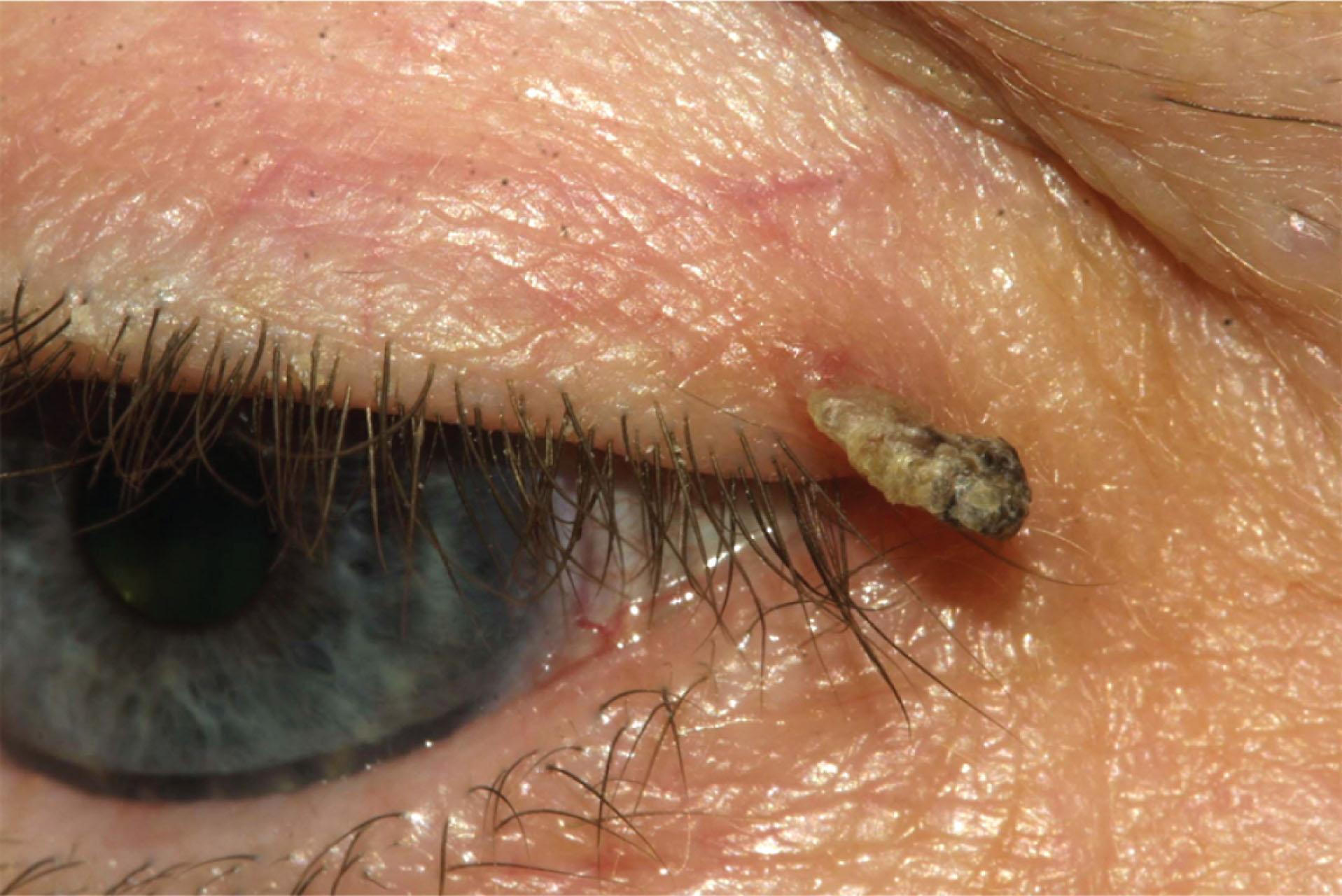
Seborrheic keratosis, also known as senile verruca , is a common benign epithelial neoplasm that may occur on the face, trunk, and extremities. These lesions usually affect middle-aged and older adults, occurring as single or multiple, greasy, stuck-on plaques ( Fig. 12.7.3 ). Color varies from tan to brown, and the surface is frequently papillomatous. The differential diagnosis includes skin tag, nevus, verruca vulgaris, actinic keratosis, and pigmented BCC. Seborrheic keratoses are not considered premalignant lesions. A systemic association, however, known as the sign of Leser-Trélat , denotes a rapid increase in the size and number of seborrheic keratoses, which may occur in patients with occult malignancy.
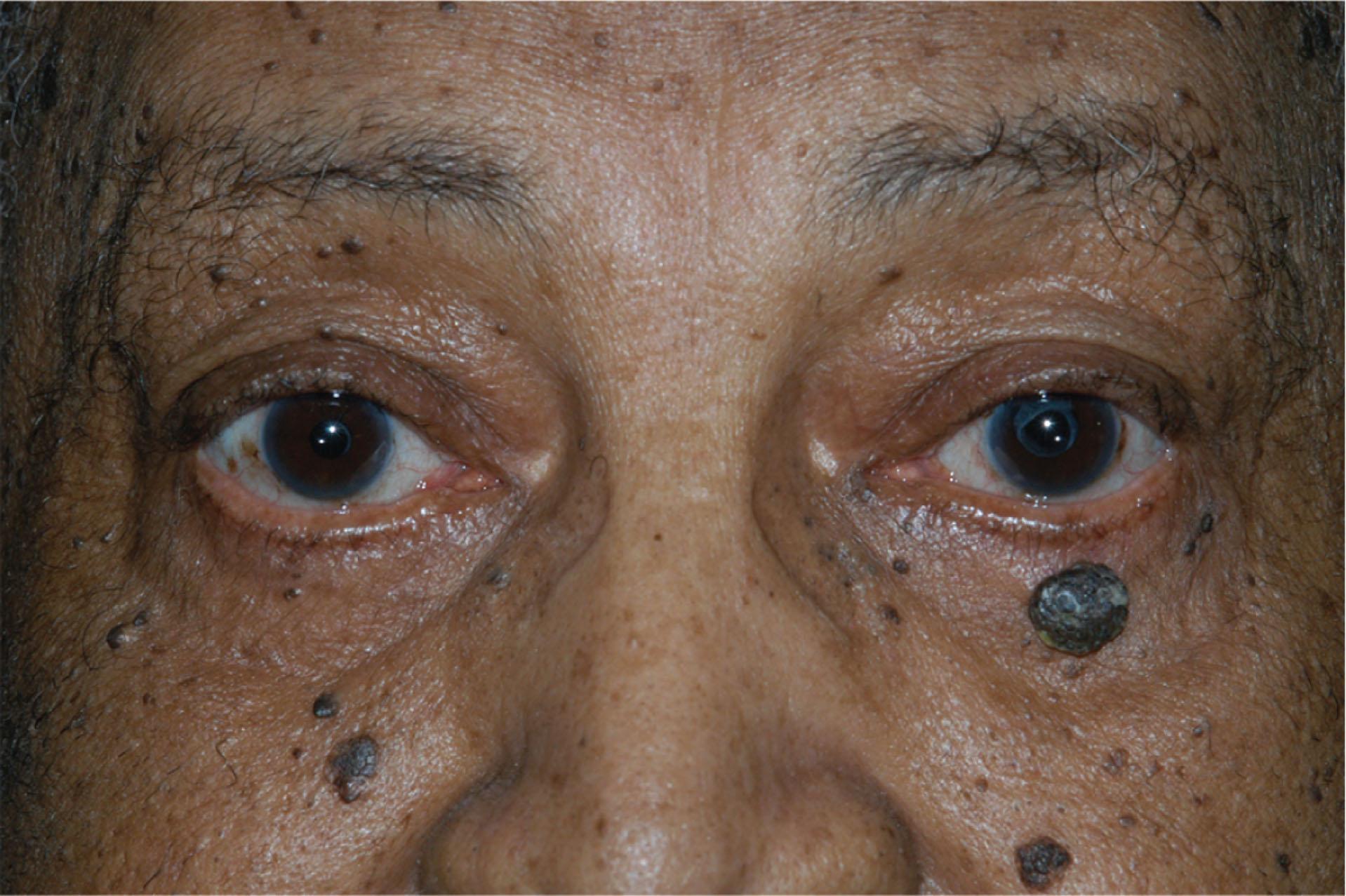
A variant of seborrheic keratosis with similar histopathological features is seen in dark-skinned individuals and is known as dermatosis papulosa nigra . These lesions usually appear on the cheeks and periorbital region as multiple pigmented papules ( Fig. 12.7.4 ).
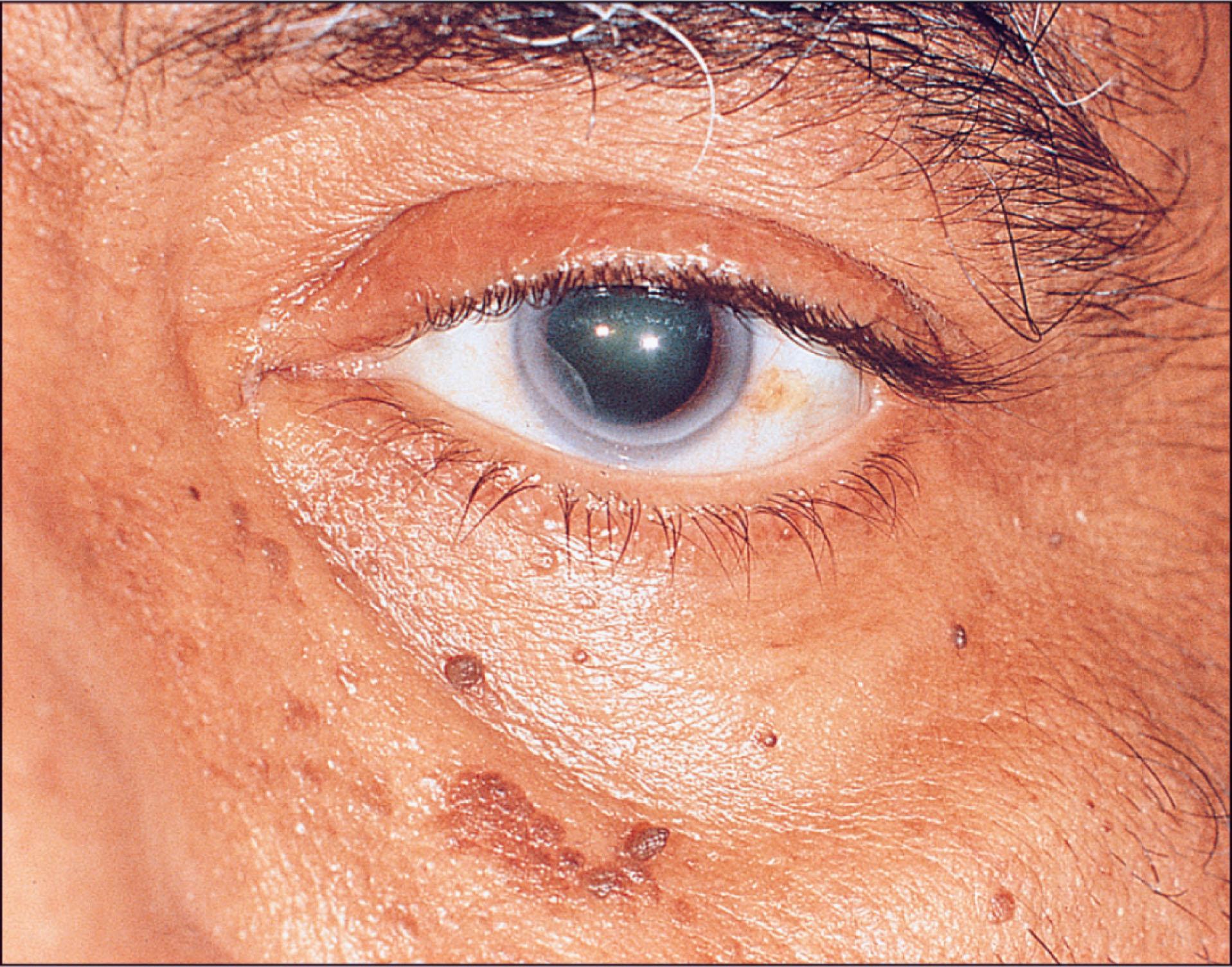
Although various histopathological subtypes of seborrheic keratoses exist, all lesions share features of hyperkeratosis, acanthosis, and papillomatosis. Most lesions contain horn cysts, which are keratin-filled inclusions within the acanthotic epidermis, and pseudohorn cysts, which represent invaginations of surface keratin. Simple excision may be performed for diagnostic confirmation, in patients with symptomatic irritation, or for cosmetic improvement. Topical 40% hydrogen peroxide and other noninvasive topical strategies are available to reduce the cost of treatment and minimize adverse sequellae.
Inverted follicular keratosis, also known as basosquamous cell acanthoma , usually appears as a small, solitary, papillomatous lesion on the face. It is a well-demarcated, keratotic mass that may appear as a cutaneous horn. The lesion may resemble verruca vulgaris and seborrheic keratosis—many consider it an irritated seborrheic keratosis. Histopathology reveals hyperkeratosis and lobular acanthosis. Proliferation of basaloid cells occurs with areas of acantholysis and zones of squamous cells, often arranged in whorls called squamous eddies . Treatment is complete excision because recurrence is common with incomplete removal.
Keratoacanthoma most commonly appears as a solitary, rapidly growing nodule on sun-exposed areas of middle-aged and older individuals. The nodule is usually umbilicated, with a distinctive central crater filled with a keratin plug ( Fig. 12.7.5 ). The lesion develops rapidly over weeks and typically undergoes spontaneous involution within 6 months to leave an atrophic scar. Lesions occurring on the eyelids may produce mechanical abnormalities, such as ectropion or ptosis, or other destructive changes of the eyelid architecture. The differential diagnosis includes SCC, BCC, verruca vulgaris, and molluscum contagiosum (MC). Patients with Muir–Torre syndrome may develop, in association with internal malignancy, multiple keratoacanthomas and sebaceous neoplasms.

Microscopically, a cup-shaped elevation of acanthotic squamous epithelium is seen surrounding a central mass of keratin. Microabscesses, containing necrotic keratinocytes and neutrophils, may be found within the proliferative epithelium. Cellular atypia may be present, making differentiation from SCC difficult. Many pathologists consider keratoacanthoma a type of low-grade SCC. Despite typical spontaneous involution, complete excision is generally recommended because the lesions may become invasive, with the potential for perineural and intramuscular spread. Additional treatment modalities, including intralesional chemotherapy, topical agents, lasers, cryotherapy, and photodynamic therapy, have also been described.
Actinic keratosis, also known as solar or senile keratosis , is the most common premalignant skin lesion. The lesions develop on sun-exposed areas and commonly affect the face, hands, and scalp and, less commonly, the eyelids. They usually appear as single or multiple small erythematous, sessile, flat-topped papules with an adherent white scale and sometimes may show a nodular, horny, or warty configuration. The development of SCC in untreated lesions reportedly ranges as high as 16% (see Chapter 12.10 ), and patients with actinic keratosis may have other cutaneous malignancies. Microscopically, actinic keratoses display hyperkeratosis, parakeratosis, and dyskeratosis. Atypical keratinocytes in the deep epidermal layers often form buds that extend into the papillary dermis. Following confirmatory biopsy, on the eyelids, these lesions are typically managed with surgical excision or cryotherapy because treatment modalities used elsewhere on the skin (topical therapy, chemical peels, etc.) may damage the ocular surface.
Epidermal inclusion cysts appear as slow-growing, dome-shaped, firm lesions of the dermis or subcutaneous tissue. Eyelid lesions are usually solitary, mobile, and less than 1 cm in diameter and may rarely be pigmented. These cysts usually arise from traumatic implantation of surface epidermis ( Fig. 12.7.6 ). Cysts may become inflamed with a foreign body granulomatous reaction.
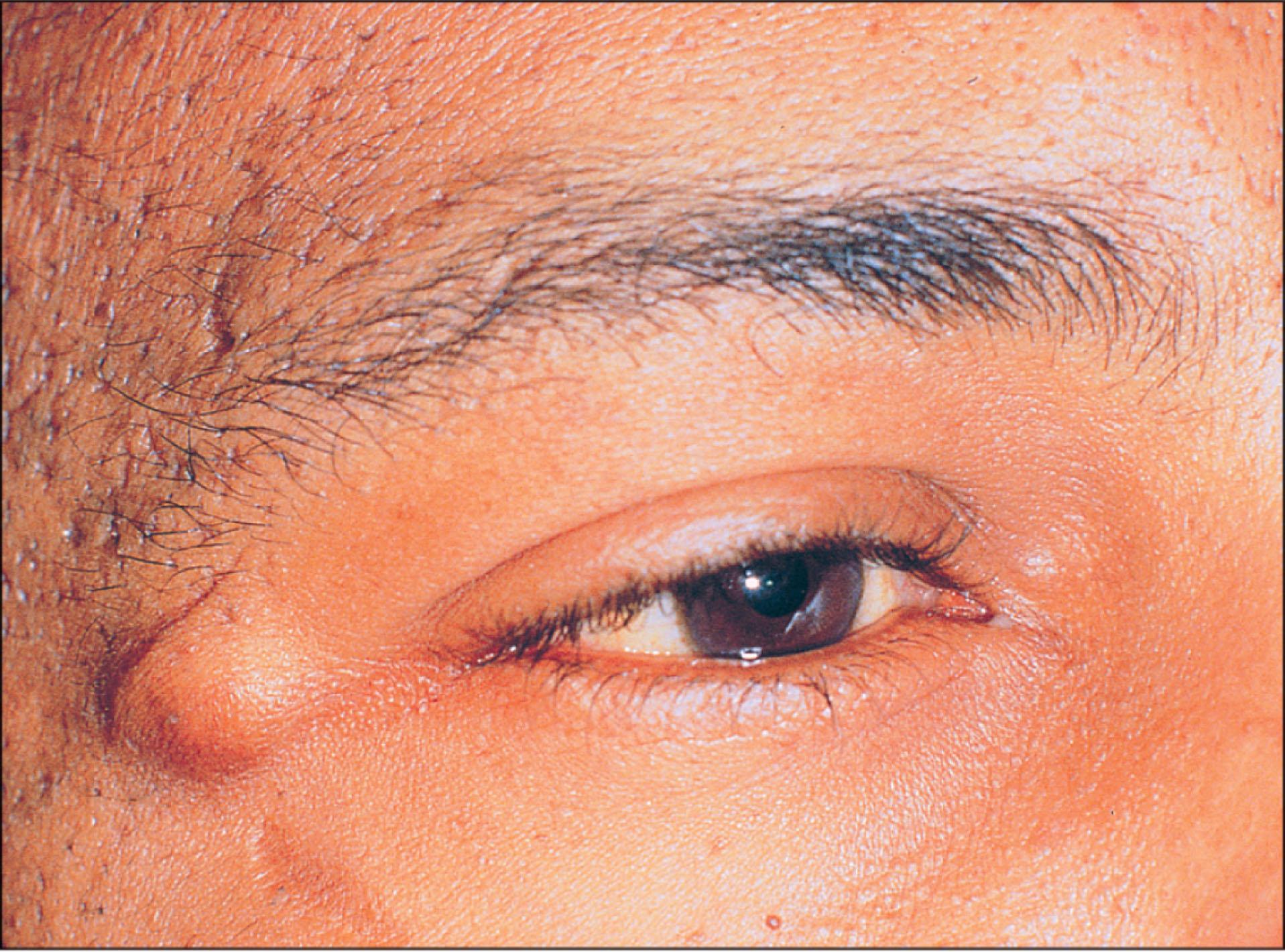
Diagnosis is based on the clinical appearance and histopathology. The differential diagnosis includes dermoid cyst, pilar cyst, and neurofibroma. Microscopically, the cyst is filled with keratin and is lined by a keratinizing, stratified squamous epithelium. Adnexal structures are not present in the cyst wall. Treatment is complete excision, preferably of the entire cyst wall, to prevent recurrence.
Pilar cysts, formerly known as sebaceous cysts , are smooth, round, movable dermal or subcutaneous masses, clinically identical to epidermal inclusion cysts. The differentiation within these cysts is thought to be toward hair keratin. These cysts tend to occur in areas with dense hair follicles and are therefore found most commonly on the scalp. They may occasionally occur in the periocular region, particularly in the brow or along the eyelid margin. Histopathology reveals an epithelium-lined cyst with palisading of the basal layer. The lining lacks a granular layer, unlike that of epidermal cysts. Eosinophilic material within the cyst comprises desquamated cells and keratin and commonly calcifies. Cyst rupture may occur and incite a foreign body granulomatous response. Treatment is complete surgical excision; incomplete excision may result in recurrence.
Although generally considered in discussions of orbital lesions (see Chapter 12.10 ), epidermoid and dermoid cysts are included here because they may appear as an eyelid mass. These cysts can occur as superficial, subcutaneous, or deep orbital lesions and rarely can occur within the eyelid. Both are benign choristomas (composed of tissue not usually found at the site) that are firm, slowly enlarging, nontender, and most commonly seen in the lateral upper eyelid and brow region ( Fig. 12.7.7 ). Superficial lesions usually are recognized during early childhood and rarely present in older adults. These cysts presumably occur secondary to entrapment of skin along embryonic closure lines. Attachment to underlying bony sutures often is present (see Chapter 12.1 ). Lesions may extend posteriorly into the orbit.
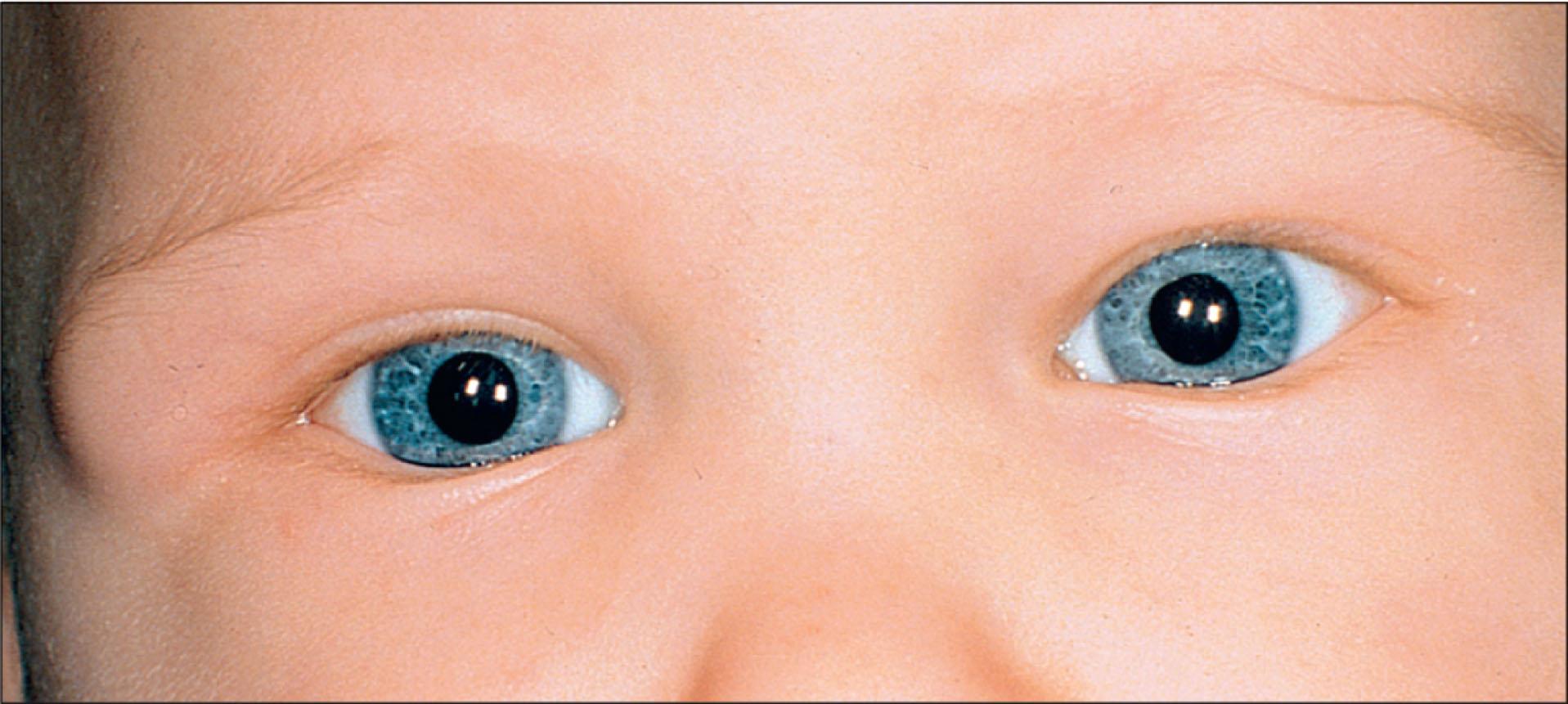
Microscopically, both dermoid and epidermoid cysts are lined by a stratified squamous keratinizing epithelium. Dermoid cysts also contain adnexal elements in the cyst wall, including hair follicles and sebaceous and eccrine glands. Treatment is complete surgical excision. Preoperative orbital imaging is indicated if the entire cyst cannot be palpated or if orbital extension is suspected. Complete excision eliminates the potential for cyst rupture, which can produce secondary foreign body granulomatous inflammation.
Eyelid lesions of adnexal origin arise from the epidermal appendages, which include the sebaceous glands of Zeis, meibomian glands, pilosebaceous units (consisting of hair follicles and associated sebaceous glands), eccrine sweat glands, and apocrine sweat glands of Moll.
Sebaceous lesions of the eyelid may arise from several sources: the glands of Zeis, found in association with the eyelashes; the meibomian glands, located within the fibrous tarsal plates; and sebaceous glands, associated with hair follicles of the eyebrows and on the cutaneous surfaces of the eyelids. The sebaceous glands create their secretions by a holocrine mechanism in which the central cells undergo disintegration and subsequent extrusion into a common excretory duct.
Milia form as multiple firm, white lesions that range between 1 and 4 mm in diameter. They usually appear on the face and commonly affect the eyelids, nose, and malar region ( Fig. 12.7.8 ). Lesions may occur spontaneously or secondarily as a result of trauma, radiotherapy, skin infection, or bullous diseases. Occlusion of pilosebaceous units with retention of keratin is thought to be the causative mechanism. Histopathology reveals a dilated, keratin-filled hair follicle, with compression and atrophy of the adjacent sebaceous glands. Treatment includes simple incision, electrodesiccation of the surface, or puncture and expression of the contents.
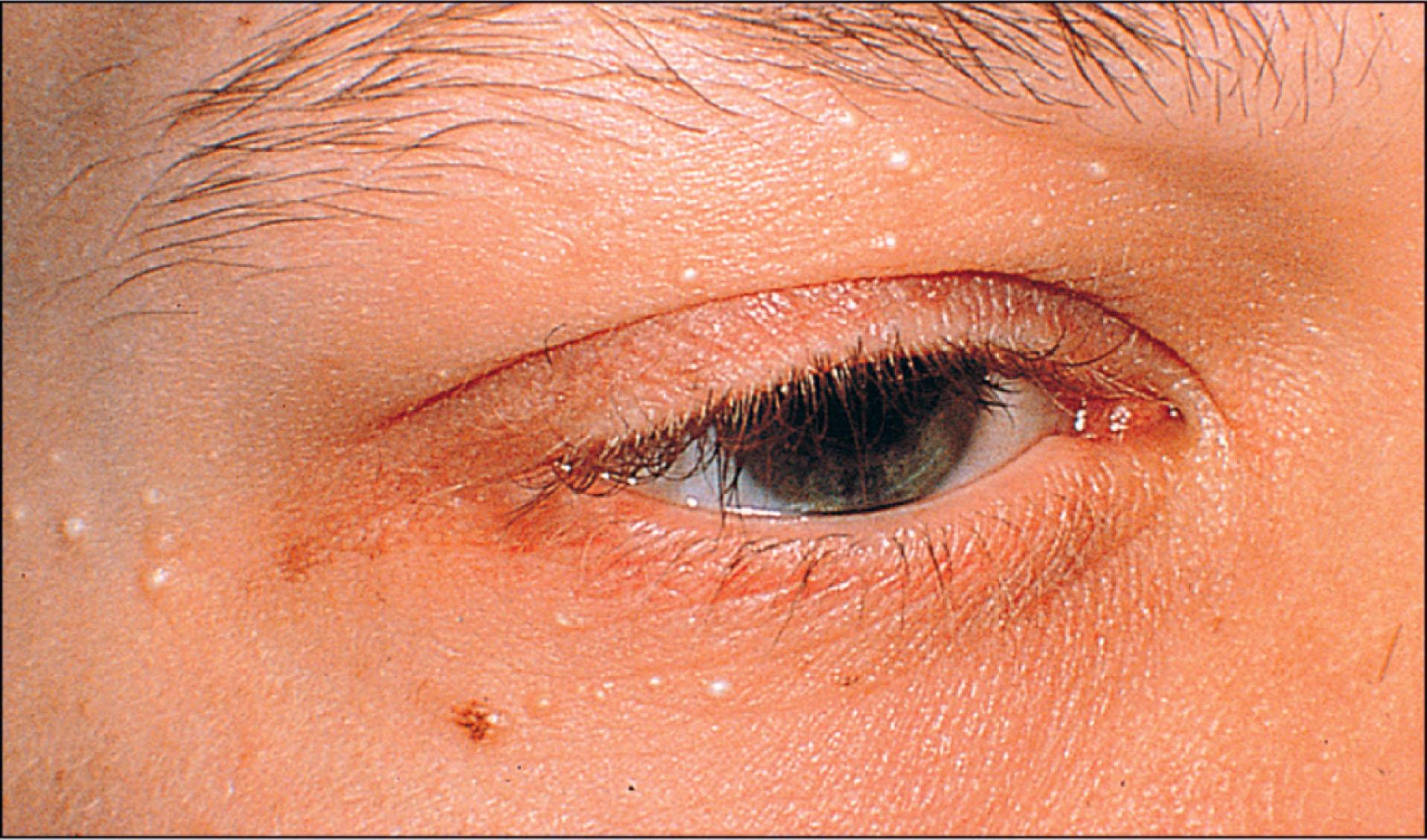
Sebaceous adenoma is an uncommon lesion that usually appears in the elderly as a solitary yellow papule, with a predilection for the eyelid and brow. The importance of this and other benign sebaceous neoplasms is the association with internal malignancy, known as the Muir–Torre syndrome . Sebaceous adenoma is seen in about 27% of patients with Muir–Torre syndrome. Even a single cutaneous sebaceous neoplasm may be significant, so patients should be evaluated accordingly. Patients with this syndrome also may develop other tumors with sebaceous differentiation and multiple keratoacanthomas. Microscopically, sebaceous adenomas are well-circumscribed lesions with lobules containing an outer layer of basal germinal cells that become lipidized centrally. Treatment is complete surgical excision.
The eccrine sweat glands are found throughout the cutaneous surface of the eyelids. They are composed of three segments: an intradermal secretory coil, an intradermal duct, and an intraepidermal duct.
Eccrine hidrocystomas, also known as sudoriferous or sweat gland cysts , appear as solitary or multiple small nodules on the eyelids but not on the eyelid margins. The overlying skin is shiny and smooth, and the cyst usually is translucent and fluid filled ( Fig. 12.7.9 ). Eccrine hidrocystomas are thought to be ductal retention cysts, which tend to increase in size in hot, humid weather. The differential diagnosis includes apocrine hidrocystoma and epidermal inclusion cyst. Histopathology reveals a dermal cyst lined by a double-layered cuboidal epithelium without papillary infoldings. Treatment is complete excision.
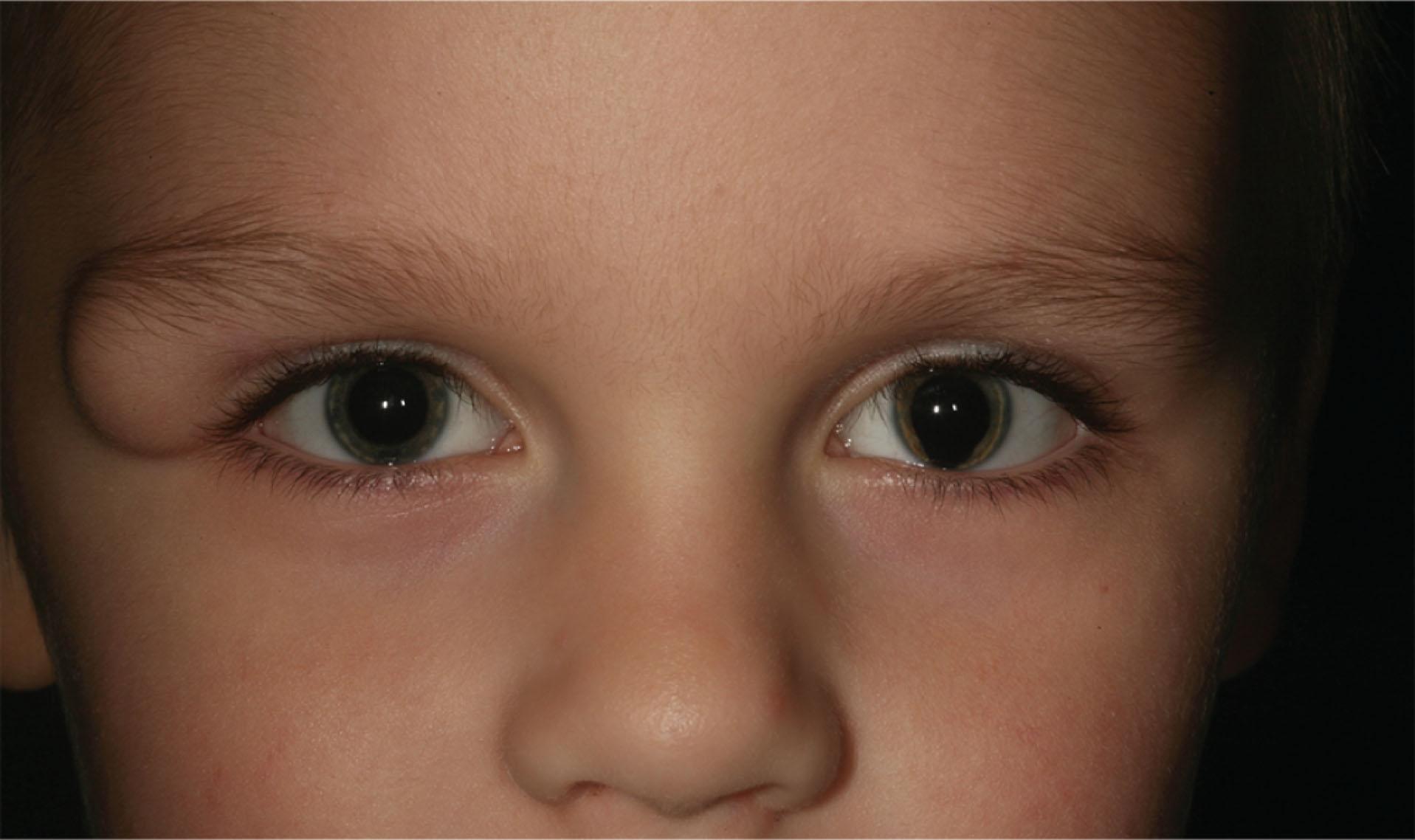
The syringoma is a common adnexal tumor arising from an adenomatous proliferation of the intraepidermal duct of eccrine glands. They occur primarily in young women, occurring as multiple, small (1–3 mm diameter), skin-color to yellowish papules distributed symmetrically on the lower eyelids and cheeks. Microscopically, syringomas contain ducts lined by double-layered cuboidal epithelium embedded in a dense fibrous stroma. The ducts may taper to a solid core of cells to produce a comma-shaped or “tadpole” configuration. Rarely, syringomas can undergo malignant transformation. Treatment modalities include surgical excision, electrodesiccation, or resurfacing with a carbon dioxide laser.
Become a Clinical Tree membership for Full access and enjoy Unlimited articles
If you are a member. Log in here